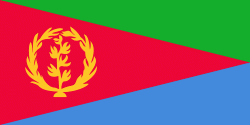Adi Keyh (Adi Keyh)
Addi Keyh (ዓዲ ቐይሕ), also Adi Keyh Adi jeganu (Addi Keyh "Red Village"), is a market town in Eritrea, lying approximatively 110 kilometers southeast of Asmara. It lies almost 2,500 metres above sea level and has a population of around 40,000 people. They speak Tigrinya and saho. The ruins of Qohaito and Toconda lie near the town. Eritrea's College of Science and Arts, which cost $17 million to construct, is located in Adi Keih.
Alternative spellings of its name include: Adi Caie, Addi Caieh, Adi Ciah, Adi Keih, Adi Qeyh, Adi Keyih and Adi Kaie.
* Yirgalem Fisseha Mebrahtu, poet
Alternative spellings of its name include: Adi Caie, Addi Caieh, Adi Ciah, Adi Keih, Adi Qeyh, Adi Keyih and Adi Kaie.
* Yirgalem Fisseha Mebrahtu, poet
Map - Adi Keyh (Adi Keyh)
Map
Country - Eritrea
 |
 |
| Flag of Eritrea | |
Human remains found in Eritrea have been dated to 1 million years old and anthropological research indicates that the area may contain significant records related to the evolution of humans. Contemporary Eritrea is a multi-ethnic country with nine recognised ethnic groups. Nine different languages are spoken by the nine recognised ethnic groups, the most widely spoken language being Tigrinya, the others being Tigre, Saho, Kunama, Nara, Afar, Beja, Bilen and Arabic. Tigrinya, Arabic, and English serve as the three working languages. Most residents speak languages from the Afroasiatic family, either of the Ethiopian Semitic languages or Cushitic branches. Among these communities, the Tigrinyas make up about 55% of the population, with the Tigre people constituting around 30% of inhabitants. In addition, there are several Nilo-Saharan-speaking Nilotic ethnic groups. Most people in the country adhere to Christianity or Islam, with a small minority adhering to traditional faiths.
Currency / Language
| ISO | Currency | Symbol | Significant figures |
|---|---|---|---|
| ERN | Eritrean nakfa | Nfk | 2 |
| ISO | Language |
|---|---|
| AA | Afar language |
| AR | Arabic language |
| TI | Tigrinya language |















